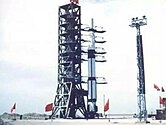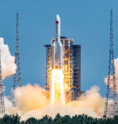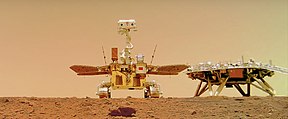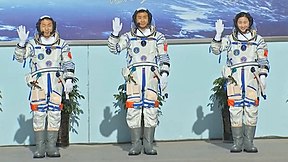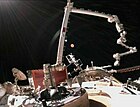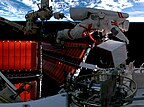This article needs additional citations for verification. (November 2024) |
| Part of a series on the |
| History of science and technology in China |
|---|
 |
The space program of the People's Republic of China is about the activities in outer space conducted and directed by the People's Republic of China. The roots of the Chinese space program trace back to the 1950s, when, with the help of the newly allied Soviet Union, China began development of its first ballistic missile and rocket programs in response to the perceived American (and, later, Soviet) threats. Driven by the successes of Soviet Sputnik 1 and American Explorer 1 satellite launches in 1957 and 1958 respectively, China would launch its first satellite, Dong Fang Hong 1 in April 1970 aboard a Long March 1 rocket, making it the fifth nation to place a satellite in orbit.
China has one of the most active space programs in the world. With space launch capability provided by the Long March rocket family and four spaceports (Jiuquan, Taiyuan, Xichang, Wenchang) within its border, China conducts either the highest or the second highest number of orbital launches each year. It operates a satellite fleet consisting of a large number of communications, navigation, remote sensing and scientific research satellites.[1] The scope of its activities has expanded from low Earth orbit to the Moon and Mars.[2] China is one of the three countries, alongside the United States and Russia, with independent human spaceflight capability.
Currently, most of the space activities carried out by China are managed by the China National Space Administration (CNSA) and the People's Liberation Army Strategic Support Force, which directs the astronaut corps and the Chinese Deep Space Network.[3][4] Major programs include China Manned Space Program, BeiDou Navigation Satellite System, Chinese Lunar Exploration Program, Gaofen Observation and Planetary Exploration of China. In recent years, China has conducted several missions, including Chang'e-4, Chang'e-5, Chang’e-6, Tianwen-1 and Tiangong space station.
- ^ "How is China Advancing its Space Launch Capabilities?". Center for Strategic and International Studies. November 5, 2019.
- ^ Myers, Steven Lee (October 15, 2021). "The Moon, Mars and Beyond: China's Ambitious Plans in Space". The New York Times. ISSN 0362-4331. Retrieved September 13, 2023.
- ^ Kania, Elsa B.; Costello, John (February 23, 2021). "Seizing the commanding heights: the PLA Strategic Support Force in Chinese military power". Journal of Strategic Studies. 44 (2): 218–264. doi:10.1080/01402390.2020.1747444. ISSN 0140-2390. S2CID 219449682.
- ^ Pollpeter, Kevin; Chase, Michael; Heginbotham, Eric (2017). The Creation of the PLA Strategic Support Force and Its Implications for Chinese Military Space Operations. RAND Corporation. doi:10.7249/rr2058. ISBN 978-0-8330-9872-6.
